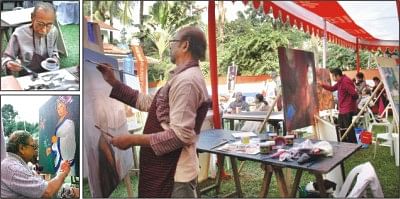Workshop
Remembering Rembrandt with aplomb
Fayza Haq
Celebrating Rembrandt's 400th birth anniversary, 20 senior artists ranging from Mohammed Kibria, Murtaja Baseer and Hashem Khan, to Javed Jalil and Rebecca Sultana Molly, held a workshop. This was at the Netherland Ambassador's residence, and the artists were guided by the Rembrandt expert Rene Klarenbeek, who had flown down from the Hague. This was sponsored by the Society for Promotion of Bangladeshi Art. Using acrylic, the artists presented their concept of the famed 17th century Dutch artist, whose influence is world wide even today, in the 21th century. Some presented abstract work like Mohammed Kibria, some semi-abstract while others like Murtaja Baseer, amalgamated the master's lines and colours with those of Bangladeshi ones, with aplomb and alacrity.Kibria's dark browns, black and the contrast of colours, with a fleck of scintillating muddy on the top of the large canvas, with the swirls and curls, done in quick decisive strokes brought in Rembrandt's superb selection of colours, which are basically remembered as variations of gold, brown, black and white. Influenced by El Greco, Van Gogh, Gauguin, Picasso and other modern artists, Kibria said that Rembrandt was one of his best beloved painters of the past. He said that 400 years after the master's birth, he can still learn from his paintings. "It was perhaps Rembrandt, who first played with the impact of light and shade in painting. His knowledge of art materials was vast. His vast wealth of paintings deserves the universal admiration of artists through the ages." Hashem Khan, on the occasion, said," I've tried to use Rembrandt's style of brush work, which I've used before, as I love the master's work since the beginning, having copied his works innumerable times as a student. I've brought in his portrait, with Bangladeshi boats at the back. "Khan wanted to invoke the idea of the master rowing in the Bangladeshi rivers and included a local Baul in his other painting. Abul Barq Alvi, who had just put on his first layer of paints, had used pre-abstraction in grays, whites and other jubilant colours to bring in the festivity of the occasion. Murtaja Baseer, in turn used figurative forms of Saskia, the master's wife, celebrating spring inspired by the portrait of Saskia and a woman walking in the stream. In the latter painting, he included the portrait of the master, in the forefront. This was done in the joyous colours of sunny Bangladesh. Naima Haque had used the lines and strokes of grays and whites, the muted colours being held together by the bright lines, sweeps, and curls -- done in buoyant hues. The final impact reminded one of the hardship of the common people of Bangladesh, as Haque explained. Farida Zaman, in turn, brought in lilting browns in his flamboyant lines and sweeps. The painting depicted a young, romantic Bangladeshi couple. The subtle lines and colours, which Zaman has often used before, emulated the master, while presenting a Bangladeshi scene. Iftikharuddin Ahmed added his own perceptive and mind-blowing remarks. Klarenbeek said that Bangladeshi artists were "sitting on a gold mine of colours and forms", going by the figures and ships that he had seen at the Bangladeshi harbours, in his short stay. The participating artists were Mohammad Kibria, Hashem Khan, Abul Barq Alvi, Murtaja Baseer, Chandra Shekhar Dey, Naima Haque, Farida Zaman, Nasreen Begum, Rokeya Sultana, Ranjit Das, Iftikharuddin Ahmed, Sheikh Afzal, Jamal Ahmed, Kuhu Plamondon, Kanak Chanpa Chakma and others.
|

Clockwise (from Top-left) Noted artistes Mohammad Kibria, Hashem Khan and Murtaja Baseer at the workshop. PHOTO: STAR |